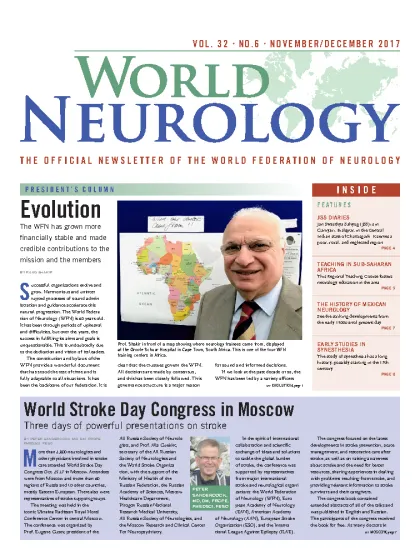Document Download: World Neurology - November/December 2017

Description:
World Neurology - Nov/Dec 2017, Volume 32, No. 6
Released: 29 Dec 2017
Published: 2 Mar 2021
Published by Ascend Integrated Media LLC, Kansas, USA
From the editors
Steven L. Lewis, MD, Editor, and Walter Struhal, MD, Co-Editor


This final issue of the year opens with WFN President Professor Raad Shakir's column, highlighting the evolution of the WFN. This insightful column marks Dr. Shakir's final President's Column as he completes his remarkably successful presidency of the WFN.
Among the other diverse contributions in this issue are reports from several recent national and international conferences. Prof. Peter Sandercock reports on the events from the recent World Stroke Day Congress that took place in Moscow, and WFN Secretary-General Wolfgang Grisold reports on the 16th Meeting of the Mexican Academy of Neurology that took place in Veracruz, Mexico. Apropos to the latter report, Professor J. Eduardo San-Esteban teaches us about the history of neurology in Mexico, a report based on a wonderful exhibit that Dr. San-Esteban curated for the many visitors to that very successful conference.
Regarding one of the many international neurologic educational activities that the WFN is pleased to be involved in, Prof. Grisold also reports on the Ninth Regional Teaching Course in Sub-Saharan Africa that recently took place in Ouagadougou, Burkina Faso.
Prof. Mamta Bhushan provides a detailed report on the medical and neurological care taking care at an institution in India called Jan Swasthya Sahyog (JSS).
Finally, in this month's history column, Prof. Peter Koehler describes the history of the intriguing neurological phenomenon known as synesthesia.
We would like to take this opportunity to thank Prof. Shakir, on behalf of neurologists worldwide, for his many and remarkable accomplishments in his pursuit of improving global neurology during his presidency of the WFN. In addition, we would like to add our sincere personal thanks for his support and confidence in providing us with the opportunity to be so involved in this important organization and to report on its activities, and the activities of neurologists around the globe, through this publication.
Highlights
President's Column
-
Evolution
The WFN has grown more financially stable and made credible contributions to the mission and the members. Successful organizations evolve and grow. Harmonious and uninterrupted processes of sound administration and guidance accelerate this natural progression. The World Federation of Neurology (WFN) is 60 years old. It has been through periods of upheaval and difficulties, but over the years, the success in fulfilling its aims and goals is unquestionable. This is undoubtedly due to the dedication and vision of its leaders.
By Raad Shakir
From the Field
-
World Stroke Day Congress in Moscow
By Peter Sandercock, MD, DM, FRCPE, FMedSci, FESOMore than 2,800 neurologists and other physicians involved in stroke care attended World Stroke Day Congress Oct. 25-27 in Moscow. Attendees were from Moscow and more than 60 regions of Russia and 10 other countries, mostly Eastern European. There also were representatives of stroke support groups.
-
Jan Swasthya Sahyog Diaries
By Mamta Bhushan SinghEight thousand neurologists descended upon Kyoto where we are attending the XXIII World Congress of Neurology, and where this article was written. If the best that humankind can be, do, and achieve has to be witnessed, Kyoto may be the correct place.
-
Regional Teaching Course in Sub-Saharan Africa
By Wolfgang GrisoldThis is a report from the Ninth Regional Teaching Course in Sub-Saharan Africa, organized by the European Academy of Neurology (EAN) and EAN Task Force, under the leadership of Prof. Schmutzhard and Eveline Sipido. The local organizer was Prof. Jean Kabore.
-
Mexican Academy of Neurology
By Wolfgang GrisoldThe 16th meeting of the Academia Mexicana de Neurologica took place Oct. 31 to Nov. 5, in the town of Veracruz, Mexico. Veracruz, also known as Mexico's door to the world, is a historic city and presently a critical seaport.
-
Montreal Neurological Institute and Canadian Neurological Society
The World Federation of Neurology (WFN) and the Montreal Neurological Institute (MNI), together with the Canadian Neurological Society (CNS), are pleased to invite two colleagues from Central and South America to visit the Neurology Department of the Montreal Neurological Institute of McGill University in Quebec, Canada.
History of Neurology
-
The History of Mexican Neurology
By Eduardo SAN-ESTEBAN, MDEduardo San-Esteban, MD Mexican neurology, considered as the dedication of our country to the study of nervous system function and disorders, and as the specific attention to persons with neurological clinical symptomatology, can be traced even before the Spaniards' conquest at the beginning of the 16th century.
-
Early Studies in Synesthesia
By Peter J. KoehlerThe study of synesthesia has a long history, possibly starting in the 17th century. A search in PubMed learns that the earliest entry is from 1947. During the first decades after that, psychologists seem to have been the main group interested in the subject. However, since the 1980s, basic neuroscientists as well as clinical neuroscientists have become interested, as is witnessed from the same source (428 hits since 1947, 419 since the 1980s).







